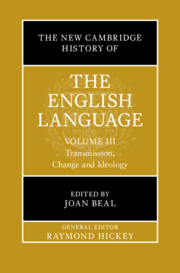Book contents
- The New Cambridge History of the English Language
- The New Cambridge History of the English Language
- The New Cambridge History of the English Language
- Copyright page
- Contents
- Figures
- Tables
- Contributors to Volume III
- General Preface
- Abbreviations
- General Editor’s Introduction
- Introduction to Volume III
- Part I The Transmission of English
- Part II Tracking Change in the History of English
- Part III Ideology, Society and the History of English
- 22 The Ideology of Standard English
- 23 Discourse of Prescriptivism
- 24 English Dictionaries from the Eighteenth Century Onwards
- 25 Networks, Coalitions and Language Change
- 26 Communities of Practice in the History of English
- 27 Indexicality, Enregisterment and the History of English
- Index
- References
26 - Communities of Practice in the History of English
from Part III - Ideology, Society and the History of English
Published online by Cambridge University Press: 23 October 2025
- The New Cambridge History of the English Language
- The New Cambridge History of the English Language
- The New Cambridge History of the English Language
- Copyright page
- Contents
- Figures
- Tables
- Contributors to Volume III
- General Preface
- Abbreviations
- General Editor’s Introduction
- Introduction to Volume III
- Part I The Transmission of English
- Part II Tracking Change in the History of English
- Part III Ideology, Society and the History of English
- 22 The Ideology of Standard English
- 23 Discourse of Prescriptivism
- 24 English Dictionaries from the Eighteenth Century Onwards
- 25 Networks, Coalitions and Language Change
- 26 Communities of Practice in the History of English
- 27 Indexicality, Enregisterment and the History of English
- Index
- References
Summary
This chapter presents one of the most recent additions to the historical sociolinguistic toolkit, a community of practice (CoP). The discussion of definitions and delimitations of this concept places it in the ‘three waves’ of sociolinguistic research and builds comparisons and contrasts with two neighbouring frameworks: social networks and discourse communities. The focus moves on to the applications of CoPs in historical sociolinguistics. The dimensions of practice – joint enterprise (or domain), mutual engagement, and shared repertoire – are redefined for the purpose of historical sociolinguistics and illustrated with examples from studies which engage with the sociohistorical and cultural context of communication. We show how language change – or, indeed, resistance to change – may be observed through a CoP lens. Prolific contexts where the concept of a CoP has been fruitfully employed include letter writing, the production of manuscripts and early prints, professional discourse, trial proceedings, multilingual practices and online blogging.
Keywords
Information
- Type
- Chapter
- Information
- The New Cambridge History of the English LanguageTransmission, Change and Ideology, pp. 751 - 773Publisher: Cambridge University PressPrint publication year: 2025
References
Accessibility standard: WCAG 2.0 A
Why this information is here
This section outlines the accessibility features of this content - including support for screen readers, full keyboard navigation and high-contrast display options. This may not be relevant for you.Accessibility Information
Content Navigation
Allows you to navigate directly to chapters, sections, or non‐text items through a linked table of contents, reducing the need for extensive scrolling.
Provides an interactive index, letting you go straight to where a term or subject appears in the text without manual searching.
Reading Order & Textual Equivalents
You will encounter all content (including footnotes, captions, etc.) in a clear, sequential flow, making it easier to follow with assistive tools like screen readers.
You get concise descriptions (for images, charts, or media clips), ensuring you do not miss crucial information when visual or audio elements are not accessible.
You get more than just short alt text: you have comprehensive text equivalents, transcripts, captions, or audio descriptions for substantial non‐text content, which is especially helpful for complex visuals or multimedia.
Visual Accessibility
You will still understand key ideas or prompts without relying solely on colour, which is especially helpful if you have colour vision deficiencies.
Structural and Technical Features
You gain clarity from ARIA (Accessible Rich Internet Applications) roles and attributes, as they help assistive technologies interpret how each part of the content functions.
